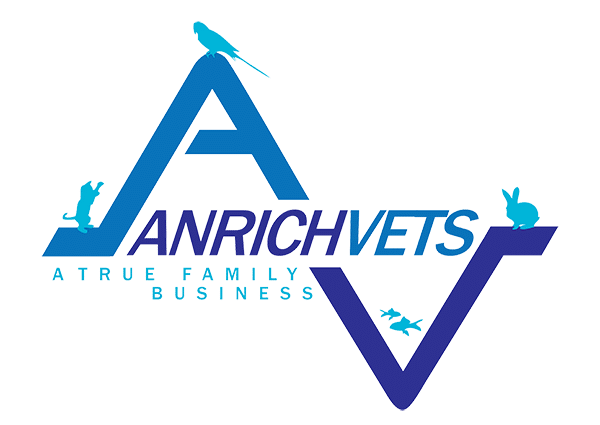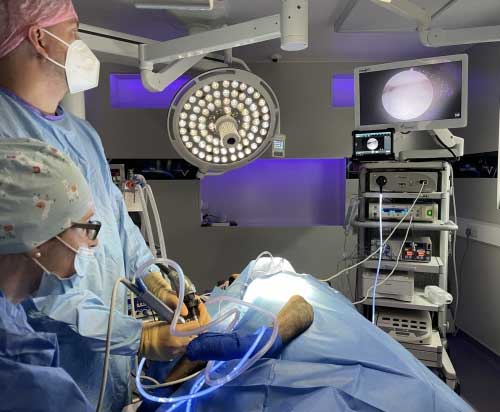Veterinary Arthroscopy
Arthroscopy, more commonly known as keyhole surgery, is a technique used to visualise and operate inside the patient’s joint capsule in order to diagnose disease or perform minor surgery within the joint. It is minimally invasive compared to other methods of joint surgery and consequently has a quicker recovery period for the animal. Arthroscopy is a specialist area, and Dr Adam Kluczny Cert (SAS) AVP MRCVS is our dedicated arthroscopy surgeon who has undergone specialist training in order to perform complex arthroscopies.
Arthroscopy Procedure
During the arthroscopy procedure, a small incision is made into the joint. An arthroscope is inserted into the space. This scope has a camera, light, and water flushing system to see inside the joint, the images are then displayed on a large monitor to see the finer details. If surgery needs to be performed, a few other incisions are made into the joint, into which instruments are placed. The surgeon can then carry out delicate surgical procedures by using the large monitor for a precise and detailed view.
Which Joint Is Arthroscopy Commonly Used on?
Arthroscopy surgery can be carried out on all joints, but it is most commonly used on elbows, shoulders, and knees. Some common diseases that we frequently treat using arthroscopy are elbow dysplasia, cranial cruciate ligament rupture and bicep tenosynovitis.
-
Elbow arthroscopy
Elbow dysplasia is the most common form of lameness in young, large or giant dogs. It occurs when the bones grow abnormally, but it can be corrected through arthroscopy surgery.
-
Shoulder arthroscopy
Bicep tenosynovitis occurs in the biceps, which run up into the shoulder joint. Shoulders can be susceptible to wear and tear, as well as injuries, but can respond well to arthroscopy surgery.
-
Knee arthroscopy
Knees can be knocked or damaged during exercise or playtime. The cranial cruciate ligament rupture is one such injury and can lead to an unstable knee joint and pain for your pet. A good surgeon can repair the ligament so that, with good aftercare, your pet should be able to enjoy his walks again.
Recovery Time
One of the key advantages of arthroscopic surgery is the shorter recovery time. Compared to standard open surgery, keyhole surgery causes far less damage as the surgeon looks inside the joint. The wounds themselves are small and will heal quickly. The work done inside the joint will heal quickly, as it will have been done precisely and delicately due to the increased visibility from the arthroscope. The instruments used during arthroscopy are smaller than standard instruments, so cause less trauma inside the joint. You will be given detailed advice about the aftercare that your pet will require, following their surgery.
Generally, your pet will be able to return home as soon as our post-operative team is happy with their condition. Your pet will need to be kept quiet for a certain amount of days following their operation, to allow the work done during surgery a chance to heal correctly. If you are concerned about keeping your pet quiet, please ask for advice.
Advantages
The main advantages of arthroscopic surgery over standard surgery are the increased recovery time, and the extra degree of precision that the arthroscopic procedure gives to the surgeon. It is far less invasive and aggressive than more conventional forms of treatment.
Cost
The cost of small animal arthroscopy can vary across different veterinary practices. Here at Anrich Vets, we always hold the interests of the animal at the heart of all that we do. We aim to provide an exceptional quality of services for an affordable price. Each case is different, so please speak to us for a personalised quote.
Refer an Animal to Us!
Here at Anrich Vets, we work with animals, and their owners, and referring vets from across the region. Not all veterinary practices have the facilities, or the advanced training to be able to offer arthroscopic surgery. Your vet may advise that it is the best form of treatment and refer your pet to us. We understand that this is a stressful time for pet owners, and we always explain clearly what the operation entails, and the post-op care that your pet will need. Good aftercare will help to improve the recovery time and success of the operation. Our supportive team will be here to help you throughout the process, from initial consultation to enjoying that first off lead walk again. Contact our professional and friendly team, here at Anrich Vets, on 01942 242001
You may be interested in reading: Elbow Dysplasia in Dogs

